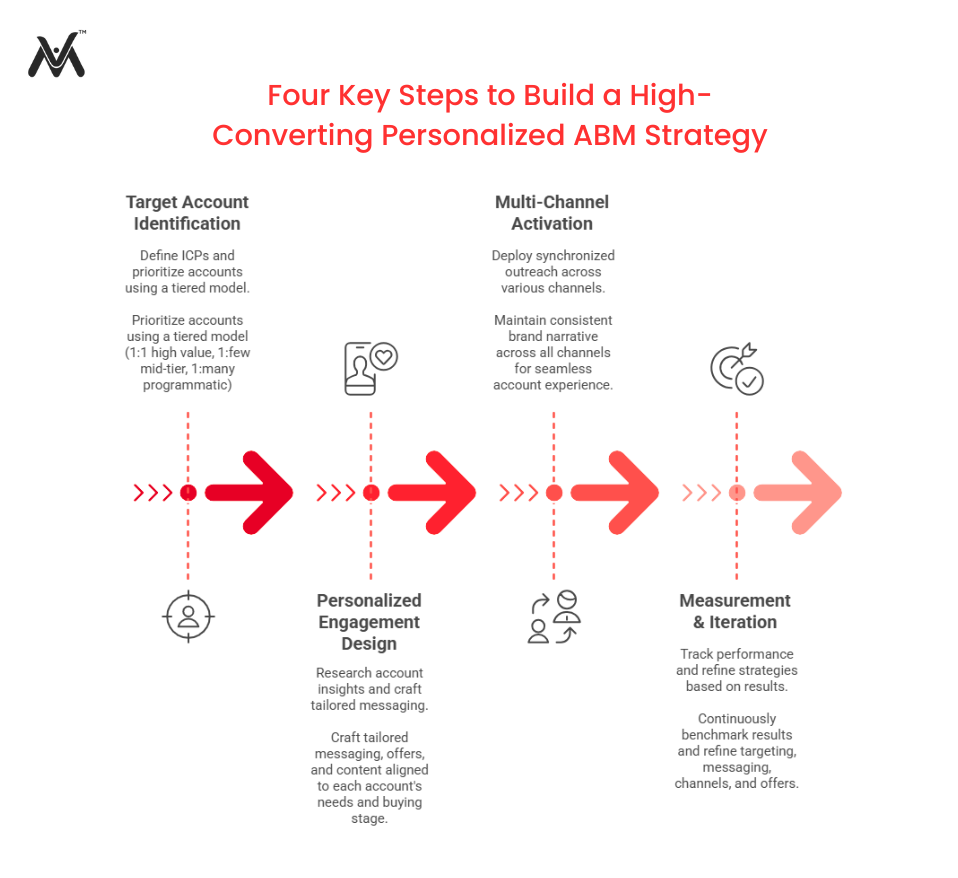Build a Personalized Account-Based Marketing Strategy That Converts
Deploying a personalized account-based marketing strategy optimizes the seamless digital experiences of the target accounts and optimizes the sales revenue.

Account-based marketing is a technique employed by B2B marketers to identify and target the accounts they value the most. Deploying a personalized account-based marketing strategy optimizes the seamless digital experiences of the target accounts and helps the marketers optimize their revenue and increase their profit margins by:
- Focusing on the most valuable customers
- Successfully aligning marketing and sales, &
- Making optimal use of the data of prospects, as well as, the existing customers
The term personalization in account-based marketing means not just identifying and targeting the accounts of high-value, but also deploying account-based data and technology as key account-based solutions to help companies attract engage and convert prospects and then analyze their performances by competitive benchmarking.
Read more on How to Assimilate Competitive Benchmarking in Social Media.
Building a personalized account-based marketing strategy has several benefits, including the following:
- Establishing a well-defined and succinct list of target accounts defined cumulatively by the marketing and sales teams.
- It helps in developing account-specific insights and in generating specific contacts for those accounts.
- Building a personalized account-based marketing strategy not just helps in creating content and messages tailored to the specific target accounts, but also helps in their effective deliverance, through account-specific interactions and campaigns.
According to a survey by ITSMA, 84% of marketers acceded that ABM develops better ROI than other marketing programs. Furthermore, according to a survey by SiriusDecisions, 92% of B2B companies recognize the value in ABM.
A personalized account-based marketing strategy is laser-focused and optimizes the holistic web experiences of the target accounts. A personalized account-based marketing strategy ensures that specific messages and content are delivered to the target accounts to propel your ABM strategy to the pinnacle of success.
Building a personalized account-based marketing strategy ensures that efforts of personalization are effectively communicated to one target account at a time.
Issac Brower, Enterprise Sales Executive at Bizzabo summarizes the importance of building a personalized account-based marketing strategy as follows:
“The basic truth about marketing is that information rules. The more you know about the people visiting your site (and the more you can take action on what you know), the more likely you are to convert them into qualified sales leads.”
Building a personalized account-based marketing strategy is somehow similar to the traditional marketing strategy; however, the execution is slightly different, rather than just the reverse of the traditional marketing strategies.
Traditional marketing strategy starts with driving traffic to businesses’ websites, generating leads and finally converting those leads to sales.
Account-based marketing, on the other hand, turns the conversational marketing funnel upside down. Instead of starting with driving traffic, account-based marketers first identify the targets they want to sell to. In other words, the accounts that are most valuable to the company are prioritized.
Steps to building a personalized account-based marketing strategy

Building a personalized account-based marketing strategy starts with the transformation of a target account list into a digital experience strategy. Once the ABM-ers have identified the accounts they want to pursue, it becomes important for them to envision what a personalized buyer’s journey would appear like to a particular individual or key decision-makers associated with a particular target account.
Typically, building a personalized account-based marketing strategy includes the following steps:
- The mobile site of your website should be optimized to engross the attention of the buyers and to streamline the buyers’ journeys
- To deliver the right experience to the right prospect at the right time is of utmost importance and therefore, marketers should be thinking about delivering the right experience to the right person at the right time
- The digital experiences for the prospects can be tailored according to the various stages of the ABM cycle, with varying modulations of personalization, keeping the mind the level of granularity that works for a business and the data at hand.
ITSMA defines account-based marketing as follows:
“Treating individual accounts as a market in their own right.”
Building a personalized account-based marketing strategy is all about marketing to a whole organization rather than an individual. The ABM-ers need to identify the organizations that fetch the highest monthly recurring revenue (MRR) to their organizations.
After analyzing the accounts with the potential to yield the highest long-term profit to the business, the marketers need to define company size, industry, location, annual revenue, upsell opportunity, profit margins and other criteria for the target accounts that they wish to go after.
Building a personalized account-based marketing strategy means not just having target accounts at hand and focusing on improving their numbers gradually, but it also means improving relationships with the target accounts so that it not only contributes to lifetime value but also help in nursing cordial relationships that in turn help the referral traffic on the website.
You display your worth to your prospects and customers by building a personalized account-based marketing strategy, that would typically include the following steps:
1. Developing offers tailored to the needs of the prospects
Building a personalized account-based marketing strategy involves providing personalized and valuable offers to the prospects. A typical ABM program has a very specialized number of target accounts and with the help of a personalized account-based marketing strategy very high conversions can be easily generated.
2. Designing sales offers to get more appointments
The sales offers are designed to help the sales teams set more appointments for meeting the prospects. The prospects should agree on the same.
Most marketers create offers to generate leads from webinars and white papers.
Building a personalized account-based marketing strategy by including sales offers such as free technology assessments or free security audits are popular among marketers to get through the door for appointment setting.
The sales offers starting with phrases such as “I’d like to tell you what the best companies in the world are doing” or “I’d like to show you how you compare to your peers” have proved to be very effective for setting sales appointments with the prospective customers.
Read more on How B2B Appointment setting services help close Sales Leads.
3. Using Retargeting
Retargeting is another way of building a personalized account-based marketing strategy. Using omnichannel retargeting strategies helps marketers keep their brands in front of the prospects and engage specifically with specific target accounts. As highly personalized content is served to the prospects, it helps elevate the conversions.
According to Forrester, 75% of buying activity happens before a “hand raise” and thereby retargeting is a crucial part of the account-based marketing mix.
The modern account-based targeting offers use IP-addresses to identify the target accounts of the vendors while they search the internet. When these accounts come across a website in the network of properties hosting the specific advertisements for a particular brand, they are served with vendor advertisements.
Read more on How is Omnichannel Remarketing Effective in Accelerating Conversions.
4. Personalize the Conversion Paths
An effective way to building a personalized account-based marketing strategy is to optimize the experiences of your prospects on your website. ABM programs must serve the prospects with high conversion paths. Optimizing the landing pages is an impactful way of personalizing the conversion paths.
Under a personalized account-based marketing strategy, marketers can create account-specific landing pages displaying custom images, offers, copy and forms, specific to the prospects visiting the landing page.
Read more on SEO Best Practices for Landing Page Optimization.
5. Designing the Sales Territories for boosting the conversions
Building a personalized account-based marketing strategy includes assigning salespeople to specific territories, based on their likelihood to close a deal.
Under the social proximity territory planning, a sales organization assigns specific accounts to their salespeople. This is based on the quality and quantity of social connections to a particular account.
Besides the social proximity territories, there are other territory planning options as well including tracing for any previous selling records, looking at the past selling histories of particular salespeople for figuring out any patterns.
6. Testing Direct Emailing to the Executives
Direct mail marketing being a direct marketing tactic, can be an effective way to reach the targeted group of executives, thus helping to build a personalized account-based marketing strategy.
As the executives don’t often register for webinars, download whitepapers, respond to unsolicited emails or follow the company or salespeople on diverse social channels, direct emailing works the best for them.
7. Employing Social Listening
Building a personalized account-based marketing strategy includes personalizing communications to an account based on the current initiatives and challenges faced by the accounts.
As companies evolve quickly, smart vendors trigger events at their target accounts and monitor the changes.
Understand what is happening at the company level of the target accounts by monitoring their social activities and by subscribing to sources of authentic public information such as Google alerts.
Social data is invaluable to the account-based marketing model and to build personalized account-based marketing strategy organizations should be agile and re-direct or re-message whenever a piece of new information is discovered.
Read more on The philosophy of Social Listening.
8. Employing list building for figuring out legitimate role-based contacts
Deploying vendors for creating lists based on roles and responsibilities that guarantee that contact is still active is an excellent approach to building a personalized account-based marketing strategy. Utilizing such list building practices, account-based models can seed the database with the right contacts.
With the help of a Role-based list, a company can ask for roles like the person in charge of its infrastructure. Often titles only can be misleading and don’t tell people enough about the job roles.
Read more on How to Build and Develop Email Lists for B2B Marketing.
9. Purchasing white papers and webinar leads for target accounts
This approach to building a personalized account-based marketing strategy leads to a higher cost for lead acquisition. Though the cost-per-lead is higher, the method is still worth the price for supporting account-based marketing endeavors.
Of late an increasing number of online lead generation organizations are allowing companies to filter their lead purchases by company name. If one is focused on target accounts, they can ask their lead generation vendors that they will be buying leads only from the specific companies.
This practice is unlike the past when a lead buyer purchased leads from a media company and they were only allowed to filter by specific segments such as company size, job titles or geographic location.
10. Creating one-to-one c-level campaigns
The goal of this step of building a personalized account-based marketing strategy is to try to match relevant employees with the relevant employees of the prospects.
C-level to c-level outreach assigns CEO to the CEO or another c-level executive to his/her peer at the target account. The campaign can be started by an email or direct mail from this person and could follow up with a phone call.
The outreach should be personalized, real and professional, mentioning the business reasons for these executives to connect.
Organizations should support every aspect of this campaign including writing the message.
Following this an inside sales member can follow-up via phone to the admin of the executive and try to set up the meeting.
Once the c-level executives are assigned organizations can also assign VPs, inside sales reps, and marketing to prospects at target accounts.
11. Using the non-sales employees to discover connections to Target Accounts
To build a personalized account-based marketing strategy marketers shouldn’t overlook the potential relationships that other employees in an organization can have with the target accounts.
There is a feature called TeamLink in LinkedIn Sales Navigator that provides visibility into the connections other employees in the companies have with contacts at the specific target accounts of the companies.
Wrapping Things Up
The vital benefits of employing a personalized account-based marketing strategy are deciphered as ABM targets its efforts to one customer at a time.
Casting an impersonal net will only catch you small fishes and this, unfortunately, is the case with most businesses. Employing ABM however, allows marketers to target one customer at a time and is analogous to fishing with a pole designed for a bigger catch, one at a time.
Valasys Media helps you generate qualified sales leads and optimize your marketing endeavors. Being a well-renowned name amongst the B2B service provider companies, we deploy our services such as Event Marketing, Content Syndication, Lead Generation, Contact Discovery, Account-Based Marketing, Lead Nurturing & Appointment Setting services to help marketers generate quality leads, nurture them and even convert them to the sales by personalizing and streamlining the sales cycles of the customers.



